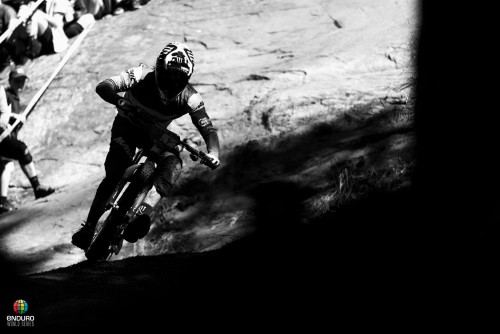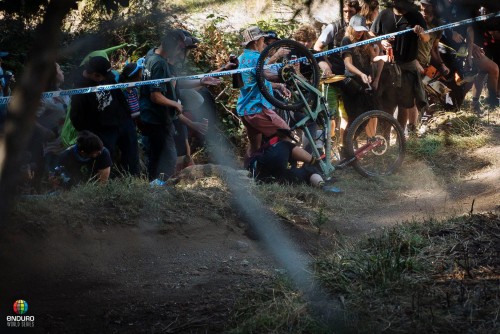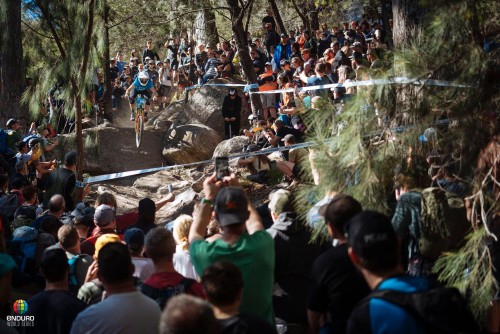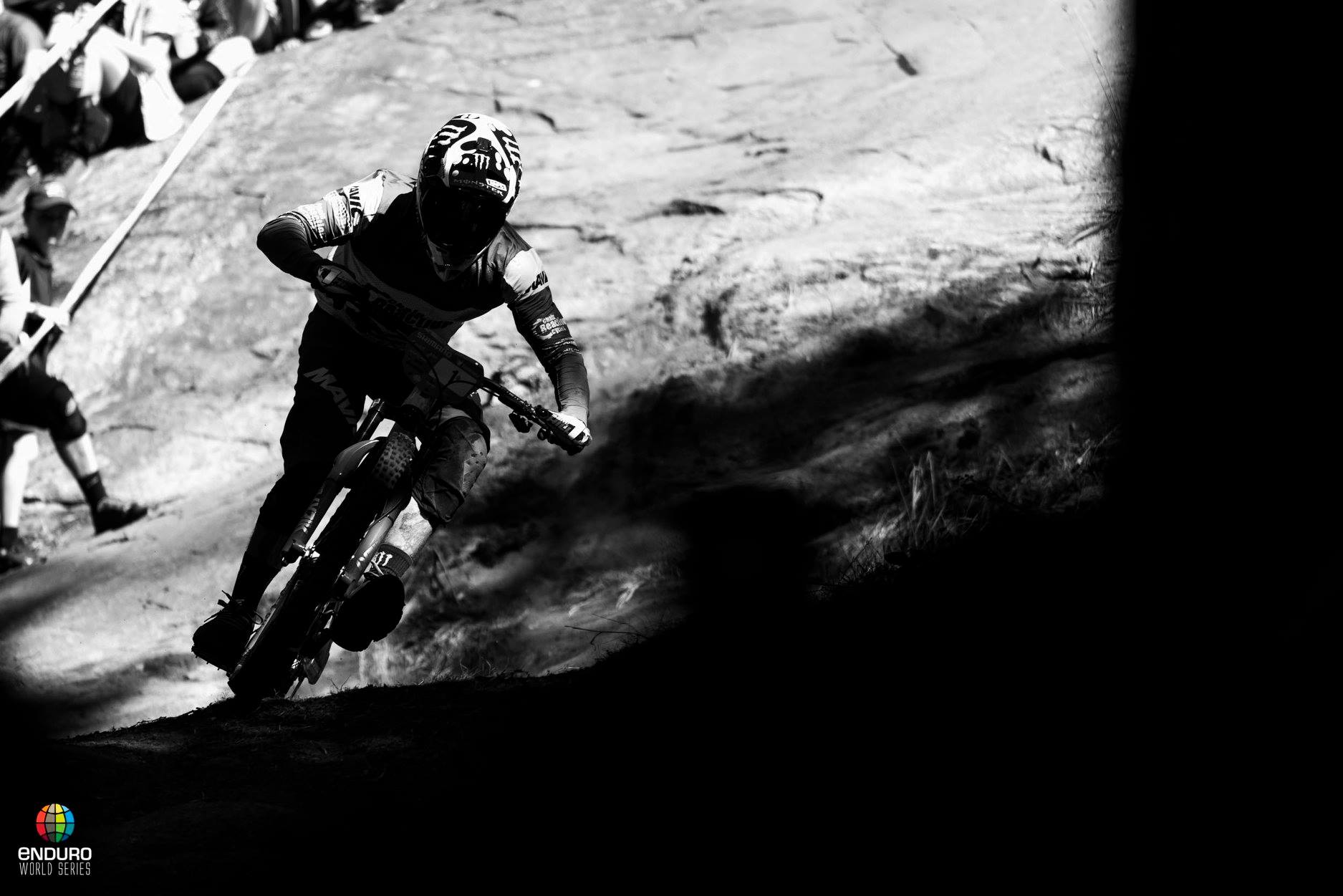5 Things to think about
- Wheelsizes – Business, party or full on orgy? Does anyone care? I think the answer is YES. But you must care for the right reasons. Isolating the diameter of wheels as a sole variable that will make or break your performance will most certainly just melt your head and break your brain. 97.5 is here to stay, at least medium term. Yes, a Class A ball ache for a privateer carrying different diameter tyres etc… but it’s gonna work as proven in both DH and EWS races. My hunch is that the mass of a rider and kit on a bicycle so greatly outweighs that of the bike and wheels that the 27.5/29 mis—match is negatable. On average a rider will be five times heavier than their bike. All that mass shifting to apply technique…. well you see my point. Last year 27.5” bikes dominated races, as did 29” bikes in both men’s and women’s racing. Now 2019 is here, fresh faced and fighting fit and the first two races where won by a variety of wheel diameters in all categories; the common denominator was a rider/bike/suspension/technique quadrant that was dialed in. Synergistic bliss allowing for optimal technique application under time and fatigue duress on stage. There’s a lot more to all that and a lot more time invested in preparations than the diameters of tyres.

- Ladies Racing – Big healing vibes to Mrs. Ravanel. Bon retablissement! Taking big leaps in thought from small data sets is dangerous, that said the gap between first and second for the ladies in 2017 in Rotorua was the same as the gap between first and seventeenth in 2019. Over three minutes. We know from more than a few seasons now that when Cecile is on it, she really is ON-IT! My experience tells me that a large chunk of this is to do with her very healthy focus on executing fast riding on demanding trails in training and far less hours devoted to “number crunching” chasing fickle physiological goals than her competition! Dare I say somewhat like her compatriot Morgan Charre;. a RAD rider! Cecile’s absence doesn’t detract from the other ladies racing though. All anyone can do on an individual sport is improve themselves. One trail, one rider, one clock. So, watching the battles unfold will be really exciting and with riders like Noga Korem, Bex Baroana, Katy Winton and ALN racking up experience the gaps will be closing across the board regardless of names missing from start-list!

- Tasmania Race Duration – curious geek stat – Tasmania 2017 and 2019 were nearly identical duration in-terms of minutes raced. For both men and women, I’ll let you go search out the details yourself, but 2019 had 6 stages, 2017 had 7 but the BIG BUT was that 2017 was a slog of a race, wet and wild. Anyways, Isabeau won both editions, there are some little details in that day of racing for the ladies that stand out but really, it’s the men’s racing that has some changes. 2017 saw Adrien Dailly take the win; three seconds ahead of third place and twenty-four ahead of tenth. 2019 saw Mr. Maes on a racing roll and with it putting twenty-three seconds into third place and over forty into tenth. So quite the change from 2017………. But this is where critical analysis of performance and not just results needs to be slammed down on the table with a fat SLAP. As I repeat ad nauseum when chatting reflection with athletes – the clock does not lie; but it never tells the full story! Not taking one ounce away from Martin’s stunning performance, a dry race allows for a far higher chance of a “perfect” race. Perfect? What I mean is a race where a rider executes each stage to their liking, executed with precision based off a plan and a strategy that then gets adapted to the race, bike and rider conditions to optimise speed from A to B. Along the same lines of thought a perfect race or excellent performance can leave you with a big winning margin. Judging by the time gaps down to tenth and twentieth, Martin had a stunning day. Likewise, simply comparing two data sets, i.e. 2017 and 2019 races isn’t enough to draw conclusions. Context matters in analysis, for example Greg Callaghan was on track for victory in the 2017 race in Tasmania, even after a crash on an early stage broke a bone in his hand. He threw the victory away with a slide out on the final stage, without both of those crashes he would have had a twenty second winning margin. Ifs and buts!
- Single Stage day – following on from above, Tasmania gave us a single practice, single timed stage Saturday; partially to fulfill EWS 80 scheduling but also to reduce the physical load on the racers and make the racing about bike riding and not training volume, this is something we will see more of at EWS racing. It is also something that Martin Maes got very right. Most likely because of a business as usual attitude. The damage done on this stage whether by Martin and Isabeau over others or by individuals poor performances inflicted on themselves was noticeable. A stunning Sunday performance could turn things a-round a little, but a ropey Saturday was suicide! What was learned – this is probably a practice and mindset “thing” that will need to be trained and thought about – reflecting on hard racing lessons learned!
- The Future now – to talk briefly about training philosophy the “global” demands of a sport or event are broad, the universal or unifying themes of events; some sports like swimming or athletics have very straightforward distances or durations. Even soccer for all its stochastic wildness has two halves of forty-five minutes each. EWS has big days out on your bike, carrying some kit, shredding hard and aiming to recover fast (between stages & days), but things get muddled fast. One day or two-day races, prologues, one-or two-day practices, four to nine stages, sea-level, high altitude, mud bog or big alpine loam. I mean the aforementioned list could wrap around the world. After two races characterised by fairly flat stages that required a lot of rider input to make, maintain and craft speed – round three in Madeira is going to dish out nine stages of what could very easily be steep, wild, loose and loamy racing. What is guaranteed is that none of the nine stages will be like anything raced in Rotorua or Tasmania and maybe even none of the nine will resemble each other at all! I can’t wait.

11177 Total Views 1 Views Today

